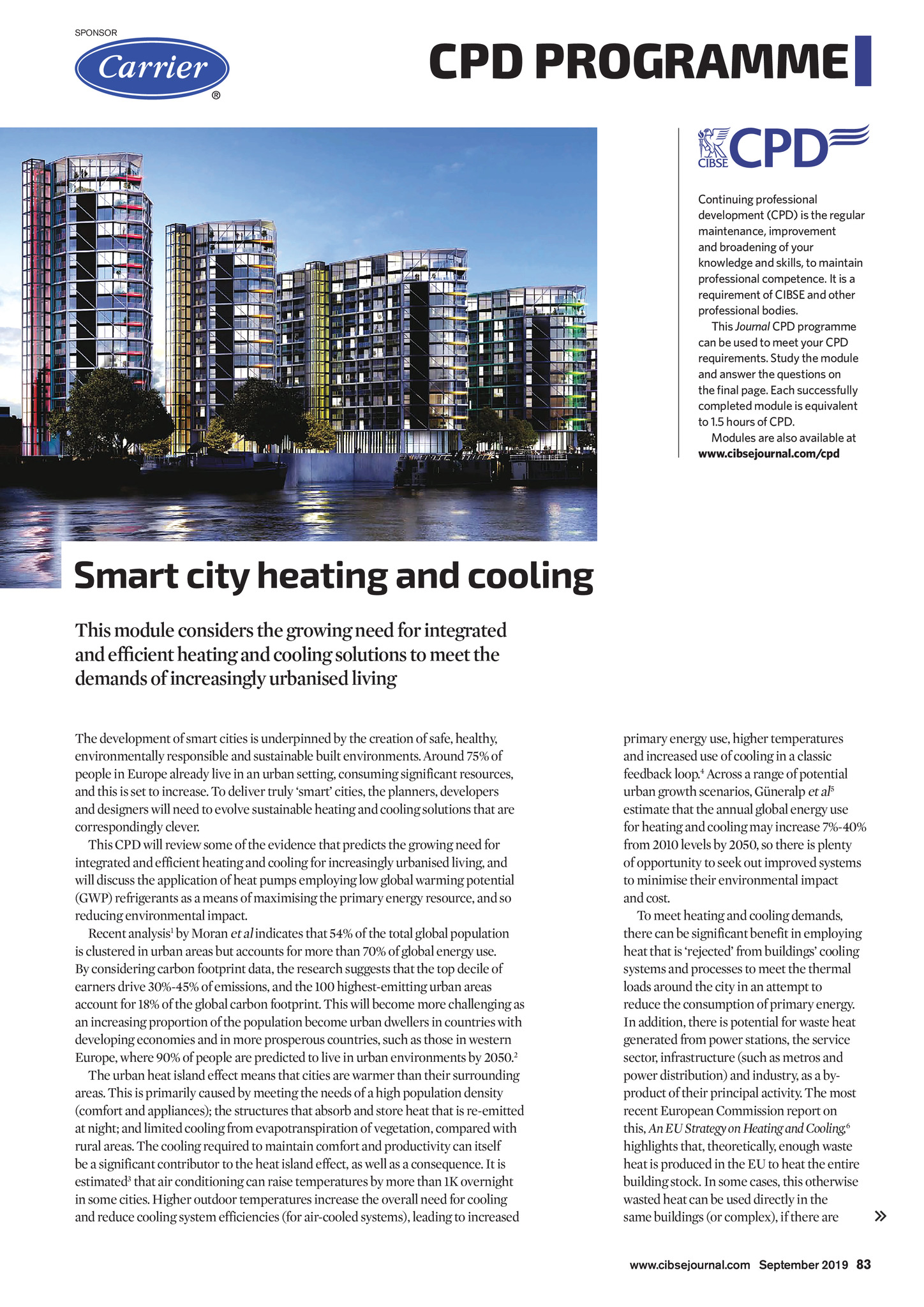


SPONSOR CPD PROGRAMME Continuing professional development (CPD) is the regular maintenance, improvement and broadening of your knowledge and skills, to maintain professional competence. It is a requirement of CIBSE and other professional bodies. This Journal CPD programme can be used to meet your CPD requirements. Study the module and answer the questions on the final page. Each successfully completed module is equivalent to 1.5 hours of CPD. Modules are also available at www.cibsejournal.com/cpd Smart city heating and cooling This module considers the growing need for integrated and efficient heating and cooling solutions to meet the demands of increasingly urbanised living The development of smart cities is underpinned by the creation of safe, healthy, environmentally responsible and sustainable built environments. Around 75% of people in Europe already live in an urban setting, consuming significant resources, and this is set to increase. To deliver truly smart cities, the planners, developers and designers will need to evolve sustainable heating and cooling solutions that are correspondingly clever. This CPD will review some of the evidence that predicts the growing need for integrated and efficient heating and cooling for increasingly urbanised living, and will discuss the application of heat pumps employing low global warming potential (GWP) refrigerants as a means of maximising the primary energy resource, and so reducing environmental impact. Recent analysis1 by Moran et al indicates that 54% of the total global population is clustered in urban areas but accounts for more than 70% of global energy use. By considering carbon footprint data, the research suggests that the top decile of earners drive 30%-45% of emissions, and the 100 highest-emitting urban areas account for 18% of the global carbon footprint. This will become more challenging as an increasing proportion of the population become urban dwellers in countries with developing economies and in more prosperous countries, such as those in western Europe, where 90% of people are predicted to live in urban environments by 2050.2 The urban heat island effect means that cities are warmer than their surrounding areas. This is primarily caused by meeting the needs of a high population density (comfort and appliances); the structures that absorb and store heat that is re-emitted at night; and limited cooling from evapotranspiration of vegetation, compared with rural areas. The cooling required to maintain comfort and productivity can itself be a significant contributor to the heat island effect, as well as a consequence. It is estimated3 that air conditioning can raise temperatures by more than 1K overnight in some cities. Higher outdoor temperatures increase the overall need for cooling and reduce cooling system efficiencies (for air-cooled systems), leading to increased primary energy use, higher temperatures and increased use of cooling in a classic feedback loop.4 Across a range of potential urban growth scenarios, Gneralp et al5 estimate that the annual global energy use for heating and cooling may increase 7%-40% from 2010 levels by 2050, so there is plenty of opportunity to seek out improved systems to minimise their environmental impact and cost. To meet heating and cooling demands, there can be significant benefit in employing heat that is rejected from buildings cooling systems and processes to meet the thermal loads around the city in an attempt to reduce the consumption of primary energy. In addition, there is potential for waste heat generated from power stations, the service sector, infrastructure (such as metros and power distribution) and industry, as a byproduct of their principal activity. The most recent European Commission report on this, An EU Strategy on Heating and Cooling,6 highlights that, theoretically, enough waste heat is produced in the EU to heat the entire building stock. In some cases, this otherwise wasted heat can be used directly in the same buildings (or complex), if there are www.cibsejournal.com September 2019 83 CIBSE Sep19 pp83-86 CPD.indd 83 23/08/2019 16:56